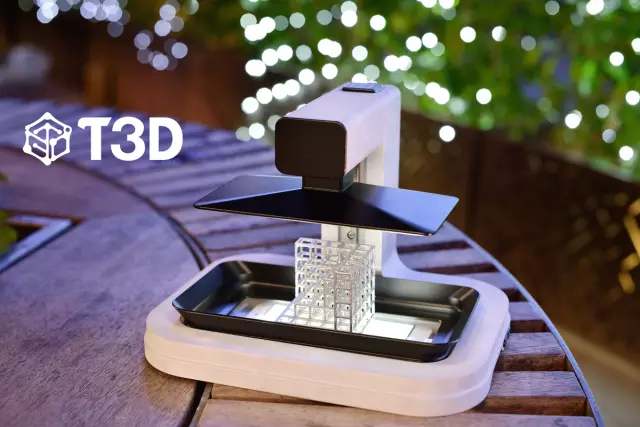
Several years ago, the arrival of low-cost desktop 3D printers generated the much-hyped concept that every household would own a 3D printer, with which they would fabricate custom goods on demand.
The hype bubble surrounding consumer 3D printing has since burst, but, in its wake, researchers and companies have been able to make real progress in improving desktop 3D printing technology. In fact, we are closer than ever before to bringing a 3D printer to every home.
The 3D printer that all of us may own does not resemble the thermoplastic extrusion devices that emerged on the market a few years back. Actually, you are most likely carrying the major hardware components for this printer around in your pocket or handbag. That’s because this 3D printer uses an ordinary smartphone to print objects with visible light.
Unveiled at CES this year was the T3D, the first smartphone 3D printer from Taiwan. To understand how it works, I spoke with Sung YiChun, founder of Taiwan 3D Tech, who was able to shed light on 3D printing with visible light
3D Printing with Your Smartphone
I met one of the pioneers of smartphone 3D printing in Taiwan in 2015. Jeng Ywam Jeng, professor of Mechanical Engineering and dean of the College of Engineering at National Taiwan University of Science and Technology (Taiwan Tech), and his students were in the process of polishing a final prototype device. Even at that early stage, it was impressive.
“This original concept was conceived of in 2012 by Professor Jeng,” said Sung. “He believes that mobile devices will eventually replace the PC as an indispensable part of our lives. Based on his experience and knowledge in the 3D printing field, he proposed a feasible project to replace the expensive optical system typically used with a mobile phone instead. He said a mobile phone is the most popular and simple digital light masking system for a DLP 3D printer.”
As with all 3D printing processes, Digital Light Processing(DLP) 3D printing begins with a 3D model, which is sliced into individual layers. Each layer is then cast by a light source onto a vat of photopolymer resin, solidifying the liquid plastic layer by layer. Typically, this light source is a DLP projector, like you might buy from a consumer electronics store, shining near-UV light. In the case of T3D’s 3D printer, it is the screen on a smartphone.
Take a look how 3D print by T3D, easy, affordable and fun !#CES2017#T3D#MyT3D#3dprint#3dprinting#3dprinted#3dprinter#makerpic.twitter.com/n6zFftePpT
— T3D Mobile3DPrinter (@T3D_3DPrinter) January 10, 2017
“Indeed, that was an unprecedented and amazing idea,” Sung continued. “After few years, this idea has been realized in the 3D printing laboratories at NTUST. In 2014, the first time I met Prof Jeng, he was very excited to tell me these remarkable results. We decided to turn this research project together into commercialization.”
They key to this process, according to Sung, is the resin itself. Photopolymers are thermosets, plastics that cannot be remelted, that are sensitive to light. Key to their composition are photoinitiators, oligomers and/or monomers. Once hit with light, photoinitiators convert light into chemical energy and cause the mixture of oligomers and monomers to form three-dimensional polymer networks. Other ingredients, such as epoxies, urethanes and polyesters might also be added to the chemistry to change the physical properties of the material, to make it stiffer or more viscous. Fillers, pigments and other materials may alter the color or other physical properties, as well.
In the case of the resin for the T3D, Taiwan 3D Tech has specially engineered a resin that hardens in response to light within the visible range, rather than near-UV range. “Our resin is mixed with a combination of different types of monomers. After visible light exposure, the special resin will solidify through the reaction of polymerization. This is what makes T3D comparatively different from traditional 3D printers,” Sung said.
Read more at ENGINEERING.com

